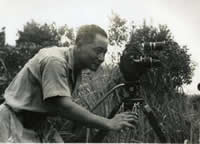Making Newsreels
 Between 1910 and 1979 the newsreels, released twice a week in British cinemas, were a major news medium, and gave millions their picture of national and world events. The newsreels were shown in cinemas as part of the overall programme, which could include cartoons, trailers, advertisements, a second feature and the main feature film. There were also specialised newsreel theatres, often located in railway stations.
Between 1910 and 1979 the newsreels, released twice a week in British cinemas, were a major news medium, and gave millions their picture of national and world events. The newsreels were shown in cinemas as part of the overall programme, which could include cartoons, trailers, advertisements, a second feature and the main feature film. There were also specialised newsreel theatres, often located in railway stations.
How the Newsreels Were Made
The newsreels were produced on film (originally in black-and-white, then for their latter years in colour), and the rapid delivery, editing, processing and printing of large batches of newsfilm lay at the heart of the newsreels’ operation. The responsibility for the technical delivery of material lay with the Production Manager.
The content of the newsreel was determined by the Editorial Department. At the head of the operation was the Editor or manager of the newsreel. The News Editor had the responsibility of selecting stories for filming, instructing the Cameramen on what to film, and overseeing the editing of the results. The Commentator would deliver the spoken commentary, which was sometimes written by a separate Commentary Writer (in the silent era, titles were written, generally to the instructions of the News Editor). The Cameramen were responsible for filming the news story. In the sound era they would be accompanied by Sound Recordists, if live sound was required. If not, the story would be shot ‘silent’ and general sound effects would be added in the studio, alongside the commentary and recorded orchestral music which was such a distinctive feature of the newsreel release.
Search for people, companies and sponsors.
The Cameramen
There were around five cameramen assigned to each of the newsreels in the silent era, rising to eight or nine cameramen and sound recordists in the sound era. These would be supplemented by freelancers. Most stories were covered by a single cameraman, while major state or sporting events would require a team of a dozen or more. A cameraman could expect to film a minimum of three stories per week, two of which might be used and the third retained in the library. News editors were strict on the use of film. Cameramen had to be economical with footage, and they kept to strict rules about how a story was to be filmed. This saved on costs, but also led to a degree of formulaic style which contributed to the predictability of newsreels. The experience of one newsreel cameraman over a year is given in this document, which records every story filmed by Topical Budget’s John Hutchins over the period 1922-1923.
Download Topical Budget – John Hutchin (256Kb PDF)
 Learning on Screen
Learning on Screen